

GCSE BIOLOGY REVISION: REPRODUCTION
Please note: Text in bold is what the AQA GCSE biology specification requires an understanding of.
Asexual reproduction involves only one parent and no fusion of gametes.
There is no mixing of genetic information. This leads to genetically
identical offspring (clones). Only mitosis is involved.
Asexual reproduction- a type of reproduction by which offspring arise from a single organism and inherit the genes of that single parent only. Thus, it does not require the fusion of gametes (unlike sexual reproduction). In almost all cases, the number of chromosomes does not change. Offspring produced from asexual reproduction are often referred to as clones as they are genetically identical to their parents.
Organisms that use asexual reproduction examples:
Bacteria
Specific plants like strawberries, potatoes and onions (they use different techniques to asexually reproduce)
Spore production by fungi
Asexual reproduction uses mitosis. Definitions of mitosis have previously been discussed, so go back if unsure. Above is a diagram demonstrating mitosis.
Mitosis participates in the cell cycle, this involves
Cell growth and increasing numbers of structures within cells
Copying of genetic material
Mitosis occurs leading to chromosome separation and cell division
Be careful! Candidates often confuse mitosis as being exclusive to bacteria and plant cells. Mitosis occurs in human cells. All our cells that are not sex cells divide by mitosis. For example, our liver cells. The cells in our body are constantly going through life cycles, they are created and they die. They constantly need to be reproduced, and thus, they divide by mitosis. The only cells in humans that go through meiosis are the female egg cells and male sperm cells.
So, what are the uses for mitosis?
Growth
Repair of damaged tissue
Replacing old worn-out cells
Students should be able to explain how meiosis halves the number of chromosomes in gametes and fertilisation restores the full number of chromosomes.
This point in the specification has been previously discussed.
Cells in reproductive organs divide by meiosis to form gametes.
Reproduction organs means sex cells (e.g. sperm cells)
When a cell divides to form gametes:
copies of the genetic information are made
the cell divides twice to form four gametes, each with a single set of chromosomes
all gametes are genetically different from each other.
Gametes join at fertilisation to restore the normal number of chromosomes. The new cell divides by mitosis. The number of cells increases. As the embryo develops cells differentiate.
Knowledge of the stages of meiosis is not required.
Tips for revision:
Whilst you are not expected to know the stages of meiosis, they could still give you a diagram with the stages of meiosis. In this case, you would need to be able to recognise that it is in fact meiosis. To do this, look out for the number of chromosomes in each cell at the end of the diagram. If there are 23 chromosomes in each, then you know it is meiosis. Additionally, if the chromosome number changes throughout the cycle, then you know it is meiosis. If there are 4 cells at the end of the cycle, you know it is meiosis. If there are two, then it is mitosis.
do some practice quizzes online to check that you know the difference between the two
whilst I was at school, some people remembered the difference like this: toes are not sexy = mitosis are not sex cells.
Make sure you are fluent in the terminology
Don’t panic, there are plenty of excellent videos on Youtube if you are still unsure.
Image- https://www.bbc.com/bitesize/guides/z9pkmsg/revision/1

0 Comment:
Be the first one to comment on this article.